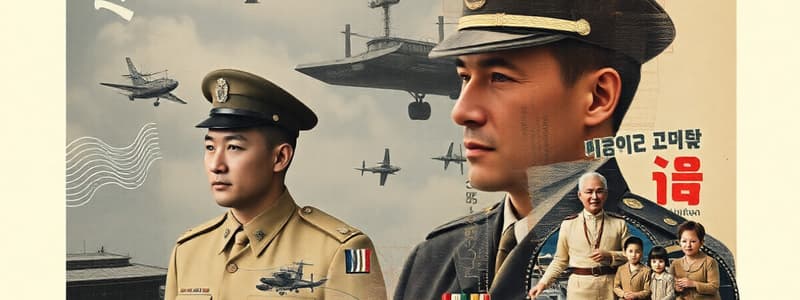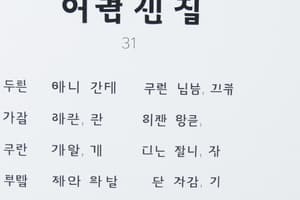Podcast
Questions and Answers
Which of the following represents a deep bond akin to family ties in Korean culture?
Which of the following represents a deep bond akin to family ties in Korean culture?
- Spec
- Jeong (correct)
- Heung
- Han
What is the duration of mandatory military service for men in South Korea?
What is the duration of mandatory military service for men in South Korea?
- 12-18 months
- 24-36 months
- 2-3 years
- 18-27 months (correct)
Only men are required to serve in the military in South Korea.
Only men are required to serve in the military in South Korea.
True (A)
What does 'Spec' refer to in South Korean society?
What does 'Spec' refer to in South Korean society?
Which belief system was fully institutionalized during the Joseon dynasty?
Which belief system was fully institutionalized during the Joseon dynasty?
What is a significant cultural contribution of Buddhism in Korea?
What is a significant cultural contribution of Buddhism in Korea?
What is Hangul?
What is Hangul?
The Japanese occupation of Korea led to increased Korean autonomy.
The Japanese occupation of Korea led to increased Korean autonomy.
The major holidays for Buddhism, Shamanism, and Christianity have varying cultural ______.
The major holidays for Buddhism, Shamanism, and Christianity have varying cultural ______.
What marked the beginning of the Korean War?
What marked the beginning of the Korean War?
What is described as a sense of melancholy in Korean culture?
What is described as a sense of melancholy in Korean culture?
Flashcards are hidden until you start studying
Study Notes
Korean Identity
- Jeong: A deep sense of connection, akin to family ties, rooted in shared experiences and hardships.
- Han: A melancholic sentiment stemming from past pain and injustices, often reflected in cultural expressions and artistic works.
- Heung: A counterbalance to Han, representing joy and exuberance, often expressed in celebrations and communal gatherings.
Military Service
- Mandatory for men: All men aged 18-36 are required to complete 18-27 months of military service, a cornerstone of societal identity and gender dynamics.
- Alternative service options: Recent years have seen the expansion of alternative service options for those unable to fulfill mandatory military duty.
National Pride
- Growing competitiveness: Korea's historical relations with neighboring countries have fostered a sense of national pride and competitiveness.
Life Pressures
- Intense competition: Intense academic and social competition, often stemming from Confucian ideals, can lead to burnout and societal pressures.
- "Spec": This term refers to specific attributes and qualifications that enhance one's social status and perceived value.
Relationships and Dating
- Directness: Direct inquiries about relationship status are common, with family ties playing a significant role in dating and marriage.
- Blind dates: Arranged blind dates are frequent, and specific anniversaries, like the 100-day mark, carry cultural significance.
- Family union: Marriage often serves to unite families, with traditional practices surrounding gift exchange and home purchases.
Driving Culture
- Aggressive behavior: Driving is often characterized by aggressive and reckless behavior.
- Lax enforcement: Lax law enforcement contributes to a distinct driving culture.
- Public transport reliance: The extensive public transportation system reduces the need for personal vehicles.
History of Korea
Pre-Gojoseon (~5000 BC)
- Linguistic ties: Early Koreans share linguistic roots with Japanese and Mongolian groups.
- Tribal affiliations: The origins of pre-Gojoseon remain uncertain, with evidence of loose tribal affiliations.
Gojoseon (2333 BC – 108 BC)
- Founding myth: Traditional narratives credit the founding of Gojoseon to Dangun, the first Korean man.
- Shamanism and Chinese contact: The period saw the standardization of Korean Shamanism and initial contact with Han Chinese around 400 BC.
- Chinese invasion: Gojoseon fell to a Chinese invasion in 108 BC.
Three Kingdoms (Baekjae, Shilla, Goguryeo)
- Military powers and trade: The Three Kingdoms period saw the emergence of powerful military states and significant trade networks.
- Goguryeo's military reorganization: Goguryeo was the first kingdom to implement a major military reorganization.
- Shilla's conquest: Shilla, through its alliance with China, conquered Baekje and Goguryeo, ushering in a period of unified rule.
Unified Shilla (668-935)
- Gyeongju as capital: The Unified Shilla period saw the capital move to Gyeongju, a flourishing trade hub.
- Buddhism and Confucianism: Buddhism and Confucianism gained increased influence during this period.
- Political instability: Internal political instability eventually led to the decline of Unified Shilla.
Goryeo (918-1392)
- Unification and Buddhism: Goryeo unified all of modern-day Korea and adopted Buddhism as the state religion.
- Cultural remnants: Cultural elements of Goguryeo and Baekjae persisted in Goryeo society.
Choseon (1392-1910)
- Military coup: The Choseon dynasty was established through a military coup.
- Neo-Confucianism: Neo-Confucianism became the dominant philosophy of the Choseon period.
- Hangul invention: King Sejong the Great invented the Korean writing system, Hangul, during this period.
- Deteriorating relations with Japan: Relations with Japan deteriorated after Choseon's successful unification.
Isolationist Period
- Reactionary period: This period represented a retreat from past conflicts with foreign powers, leading to deliberate isolationism.
- Modernization attempts: Efforts to modernize were less successful compared to Japan's modernization efforts.
Japanese Occupation (1910-1945)
- Annexation: Japan's annexation of Korea followed the assassination of a Korean queen.
- Infrastructure development and Korean autonomy: While the occupation saw improvements in infrastructure, it came at the expense of Korean autonomy.
- Rise of Christianity: The independence movement during this period saw a significant rise in Christianity, often seen as representing resistance.
The First Republic (1947)
- Separate governments: Following World War II, separate provisional governments were established in North and South Korea.
- Failed joint elections: Failed attempts to hold joint elections fueled tensions between the two Koreas due to differing political ideologies.
The Korean War (1950-1953)
- North Korea's initiation: The Korean War was initiated by North Korea with initial military successes.
- US intervention: The United States intervened in the war, playing a crucial role in the battle of Incheon.
- Stalemate and armistice: The war ultimately ended in a stalemate, resulting in a division of Korea at the 38th parallel.
Traditional Korea
Symbols
- Rich symbolism: A diverse range of traditional symbols embody Korean identity and heritage.
Multifaceted Belief Systems
- Cultural exchange: Korea's diverse religious landscape reflects a rich history of cultural exchange.
Confucianism
- Goryeo and Joseon era: Established during the Goryeo dynasty and fully institutionalized in the Joseon dynasty.
- Hierarchical order and social obligations: Confucianism emphasizes hierarchical societal relationships, familial loyalty, and social obligations.
- Emphasis on education: Education holds a high value within Confucianism, contributing to societal pressures and competitive attitudes.
Buddhism and Art
- Chinese introduction: Buddhism was introduced to Korea from China, initially embraced by the elite.
- Cultural contributions: Buddhism significantly contributed to Korean culture, though its influence declined during the Joseon period.
- Karma and reincarnation: Buddhist concepts of karma and reincarnation remain integral to its philosophy.
Christianity and Modernity
- Korean diaspora: Christianity was reintroduced to Korea by Korean expatriates during the late Joseon period.
- National identity: During the Japanese occupation, Christianity became closely intertwined with national identity and resistance.
- Educational and medical advancements: Christianity played a role in promoting education and medical advancements.
Shamanism and Folk Tradition
- Nature worship: Shamanism incorporates nature worship and matriarchal influences.
- Music and dance: Shamanic practices are deeply connected to music and dance, often integrated into other religious traditions.
- Ceremonies: Ceremonies like the Ceremony of Prosperity remain ingrained in Korean traditions.
Religious Holidays
- Multiple religious holidays: Korea celebrates major holidays associated with Buddhism, Shamanism, and Christianity, each with varying cultural and religious significance.
- Social significance of Christian holidays: Christian holidays are often celebrated in a more social context than strictly religious.
Traditional Dress (Hanbok)
- Formal wear: Hanbok is traditionally worn during holidays, weddings, and other formal occasions.
- Distinctive design: Hanbok features a distinctive and colorful design, often reflecting regional variations.
- Cultural significance: Hanbok holds a strong cultural and symbolic meaning.
Studying That Suits You
Use AI to generate personalized quizzes and flashcards to suit your learning preferences.




